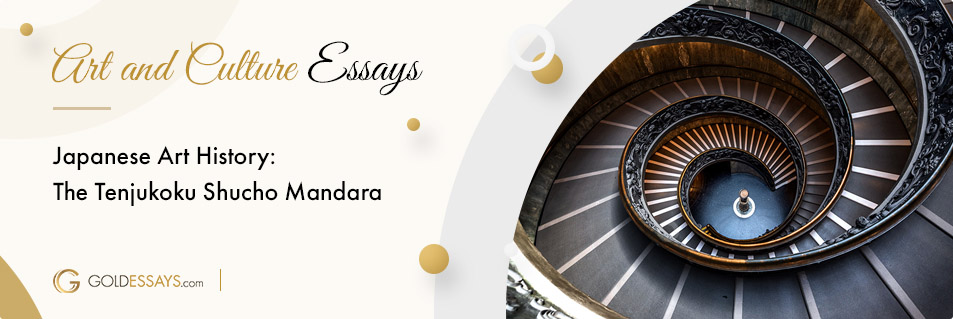Japanese Art History: The Tenjukoku Shucho Mandara

The Tenjukoku Shucho Mandara Free Essay
The article The Tenjukoku Shucho Mandara: Reconstruction of the Iconography and Ritual Context by Chari Pradel is an attempt to propose an alternative point of view on the artifact researched, The Tenjukoku Shucho Mandara. That item is traditionally supposed to be an element of the Japanese Buddhist legend about Prince Shotoku (574-622 AD) who is worshiped as a saint person as well as the father of Japanese Buddhism. Pradel claims that the artifact is not a Mandara, but a ritual curtain traditionally used in Japanese funeral ceremonies before the dominance of Buddhism. The main point of this essay is to discuss and evaluate the main Pradel’s considerations concerning the issue.
In her article, Pradel doubts that the artifact was made by the Buddhists, because of many contradictions between the archaeological, historical, and textual evidence. Thus, she claims that the previous studies concentrated the most attention on the textual and historical aspects and “did not take the visual evidence into account” (Pradel, 2004). The main difference between Pradel’s research is an intention to evaluate all groups of evidence (2004).
The author starts from the research of the so-called Shucho text traditionally used to interpret the artifact. According to that, when Prince Shotoku died the Tenjukoku Shucho Mandara was made to depict Prince’s afterlife (Pradel, 2004). Besides, there are two important details, that make possible Pradel’s doubts concerning the artifact’s Buddhist derivation. The first one is the historical information about another similar artifact that was found in the XIII century. Analyzing the Tenjukoku Shucho Mandara, Pradel assumes that it may be a combination of some fragments from both curtains from the VII and XIII centuries (2004). The actual artifact looks like separate parts of “embroidered textile randomly mounted on a support fabric” (Pradel, 2004). Thus, the assumption mentioned may be correct. Another detail is the difference in the term’s “Tenjukoku” translation. Pradel claims that it may mean both the Pure Land of Miroku of the Pure Land of Amida (2004); such uncertainty with the Buddhist terms makes the textual information very doubtful source for the identification of the date of the artifact’s creation.
Another step of Pradel’s research concerns the analysis of the images embroidered on the Tenjukoku Shucho Mandara. The main point of her attention is the social aspect of the depicted objects: she underlines the presence of the Buddhist monks among other people depicted and tries to identify the social statuses of the depicted figures. Besides, indifference from her predecessors, Pradel compares these images with those from the Korean and Chinese funerary chambers (because of the legend about the artifact’s funerary origin), and concludes that all of them belong to the same cultural tradition that presupposed their particular similarity (2004). The right side of the artifact’s section B is the largest one, and the author notes that it may help to reconstruct the general picture because it includes the images in their interrelation (Pradel, 2004). Thus, Pradel considers that such images as the red bird may serve as direct evidence of her assumption concerning the Tenjukoku Shucho Mandara’s fundamental connection with the Korean and Chinese sacral art (2004).
At last, the author mentions the assumption of Ohashi Katsuaki who claimed that the Tenjukoku Shucho was a pair of curtains (the term “Shucho” means “a curtain”) (Pradel, 2004). Through further research, she concludes that the funerary curtains were a common element of the ceremonies of a kind on the territories that belonged to the cultural area she researched before (Japan, China, and Korea) (Pradel, 2004). Thus, Pradel states that there is no strong evidence for the Buddhist origin of the artifact and it is possible to interpret it not as a Mandara, but as a pair of curtains used for Prince Shotoku’s funeral (2004).
The article provides a deep approach to the Tenjukoku Shucho Mandara because the author involves more sources of evidence such as the Chinese and Korean art, the results of archeological research, and other details that helped to overcome her predecessors’ concentration on the texts only. Besides, Pradel does not resolve the problem of the Buddhist monks depicted on the curtain (she assumes that these images do not mean the dominance of Buddhism during the artifact’s making). She also has no certain answer to the question of what the term “Tenjukoku” means. In such a way, Pradel’s research is an attempt to clarify some aspects of the Tenjukoku Shucho Mandara that needs more data to effectively oppose the orthodox Buddhist position concerning the issue.
